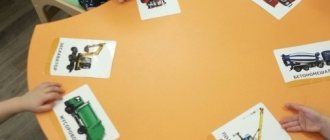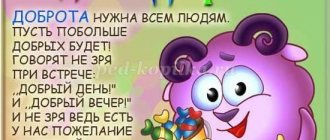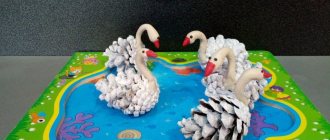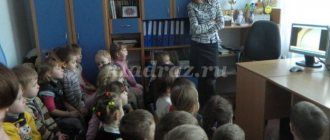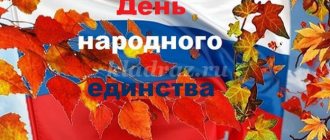Summer walk - excursion in kindergarten. Middle group
Summer fun at a preschool educational institution. Excursion to flower beds
The excursion is intended for children of middle and senior preschool age.
The teacher conducts it during a walk in the summer, but it can also be included as part of a lesson on familiarization with the natural world. Preliminary work: To consolidate the sequence of flowering of plants in the flowerbed, from April to September, a herbarium is created together with the children (dried flowers are glued to a sheet of paper in the order of their appearance) Goal : to activate children’s interest in the world around them, to systematize children’s knowledge about a specific flower - the daisy. Objectives: to evoke in children a positive emotional response to the beauty and diversity of the flower world; Teach children to compare, find common and distinctive features of colors. Develop thinking, observation, memory, and the ability to make inferences. Reinforce knowledge of the names of summer months and flowers. Preliminary work : work in the flower beds on sowing and caring for flowers, asking riddles about flowers, looking at pictures of flowers, getting to know their names.
Excursion progress
Educator: Children, tell me, is it beautiful near our kindergarten? (children's answers) - What especially decorates the territory of the kindergarten now, in the summer? (children's answers) - That's right, flowers. Let's take a tour of the kindergarten territory today and admire the beauty and diversity of the flower world.
What are the names of the places where our flowers grow? - That's right, flower beds. Our kindergarten is decorated with beautiful flower beds with various flowers. Many flowers are familiar to you, I’ll tell you about some today. Educator: Children, flowers are a symbol of happiness, kindness, beauty. Therefore, often, when you want to do something nice for a person, they give him flowers. So today I would like to give you a gift. Admire them, look at them more closely, you can even touch them, smell them, but don’t tear off such beauty, and then we will reflect your impressions in the drawings. (Children admire the flowers, some touch, look at, smell)
Educator : What time of year is it now? Name the summer months What month is it now? Now name the flowers that bloom in July. And a hint for you in our flower beds. (rose, chamomile, marigolds, calendula...) Educator: Tell me, why do the flowers bloom so beautifully in our flower beds? But in the forest the flowers are not so large.
Children: they take care of flowers in flower beds, but not in the forest. Educator : Yes, it’s correct that the flowers are large, you can clearly see them in the flowerbed, they need to be looked after. Let's remember how we did it. Children: Digged the ground, sowed seeds or planted seedlings, watered when the ground was dry, loosened the soil, weeded out weeds. Educator: The little sisters are standing in the flower beds: They have a golden eye, white eyelashes. What flower is this that I asked you a riddle about? Children: Chamomile.
Educator: Do we have chamomile in our flowerbed? Children pay attention to daisies Educator: What does this flower look like? Children: To the sun with rays Educator: Yes, chamomile is always compared to the clear sun. In our country, chamomile is a symbol of purity and kindness. There are many types of chamomile in nature, but the most famous are odorless chamomile (shows) and chamomile (shows). Chamomile flowers have amazing healing properties. Decoctions and infusions from it are used in medicine. Previously, this flower was called “Romanov flower”, over time people began to affectionately call it “daisy”. But scientifically this flower is called “nivyanik”. (Children repeat the name) Educator : Let's look at this little sun and talk about its structure. Children: Tall straight stem covered with long green leaves. The flower is held in the ground by its roots. The flower itself consists of many white petals and a yellow center. After smelling the flower, children say that garden chamomile or cornflower has no smell. Educator : Garden chamomile is an odorless plant, but it attracts insects with its color. Flying from one flower to another, flies, bees, butterflies and other insects carry pollen. (The teacher draws the children’s attention to echinacea and rudbeckia) Children, look, we still have flowers that look like daisies growing in our flower beds. Can we call them daisies too?
Indeed, these flowers look like daisies, call them what? Children: Flowers also have many petals, like a chamomile, there is a middle, a tall stem, and long leaves. Educator : That's right, these flowers are similar, but what is the difference? Children: These daisies (points to the echinacea) have pink petals, and the middle is brown, but these (points to the rudbeckia) have yellow petals, with brown spots in the middle, and the middle is also brown.
They also differ in the shape of their green leaves, and their trunks are hard and rough. (children examine the stems of these plants by touch) Educator: A plant with pink petals is called echinacea (Children repeat the name). Like chamomile, it has healing properties and is also used in medicine. If you have a sore throat, a decoction of echinacea will help, if you hurt your knee, wash the wound with the same decoction. It strengthens our body well if we use medicines and vitamins with this plant. Educator: A plant with yellow petals is also called rudbeckia. (Children repeat the name) Educator: What is the name of an ordinary garden chamomile? Children: Nivyanik Educator: Chamomile is a flower dear to the heart, kind, gentle, heartfelt, which decorates our lives, gives joy and health to a person. A small sun on my palm - A white daisy on a green leg, Yellow hearts with a white rim. There are so many of them in the meadow, how many of them there are by the river... Educator: Let's once again admire the beautiful decoration of our flower beds, the abundance of flowers. And I suggest you decorate the asphalt paths with flowers.
Draw on the asphalt those flowers that you especially like and then our kindergarten will be covered in flowers. The teacher distributes colored crayons to the children. Children draw flowers on the asphalt.
A soundtrack of children's songs will play.
We recommend watching:
Fairy tale day in kindergarten in the middle group in the summer. Scenario Summary of an integrated lesson for children of the middle group on the topic “Summer” Summer entertainment in the middle group of kindergarten. Journey to the Land of Flowers Plan of summer health work in the middle group, taking into account the Federal State Educational Standard
Similar articles:
Summer in kindergarten
Scenarios for summer holidays and entertainment in kindergarten. Middle group
Walk watching the sun in summer. Senior group
Walk watching the clouds. Middle group
Observing insects in the older group in summer
MAGAZINE Preschooler.RF
Integration of areas: “Cognition”, “Communication”, “Safety”, “Reading fiction”, “Health”. Materials and equipment: magnetic board, subject pictures depicting people working in kindergarten, poem ball. Program content: Clarify and activate the vocabulary on the topic: “Kindergarten”. "Communication". Develop children's connected speech." "Communication". To consolidate ideas about the need and importance of adult labor.” "Cognition". Introduce dangerous situations in kindergarten. "Safety". Continue introducing children to riddles and poems. "Reading fiction." Contents of GCD: Organizational moment. The teacher tells the children that today we have an unusual activity. We will go on a tour of the kindergarten and listen to the stories of the adults who work here. I ask you to be careful and remember all the stories. I also want to remind you how to behave during the excursion. Don't make any noise, because classes have started in all groups. Do not run or push when going up or down stairs. Do not touch anything without permission in the premises where you and I will enter. Don’t forget to say hello, thank you for your story, and say goodbye. Conversation on the topic “Kindergarten. Professions in kindergarten." The teacher guides the children around the kindergarten. They visit the manager's office, the medical office, the laundry room, the pantry, and the kitchen. The head of a kindergarten, a doctor, a nurse, a laundress, a storekeeper, and a cook speak to the children about their professions. They introduce children to the premises of the kindergarten, show equipment, devices, tools. Educator. Our tour of the kindergarten has ended. Remember where we visited, what we saw, what we learned new. Each of you must talk about one part of our excursion. The teacher places pictures on a magnetic board with images of the people the children are talking about. 1st child. We visited the manager's office. There we saw……… The manager supervises the work of the kindergarten. She has a lot of important things to do. (The teacher helps the children tell the story) Teacher. Very good. Now let's talk about visiting a medical office. 2nd child. We visited the medical office. A doctor and a nurse work there. (Additions from the teacher - The doctor and nurse showed us scales, a stadiometer, a cabinet and refrigerator with medicines, thermometers, syringes. All this is needed to monitor our health). Ball game. "Who's doing what?" - I will throw a ball to one of you and name your profession. You will catch the ball and list what the person is doing. Guessing riddles. The teacher invites the children to guess riddles. Smelly cutlets, salads, vinaigrettes? Children. -This is the cook. He cooks delicious dishes for us. Educator. - We teach children to count, draw, love nature, respect all work. Children. - These are educators. They teach us to count, draw, love nature, and work. Educator. You solved the riddles and gave explanations of how you did it. Well done! Finger gymnastics “Our group”. Everyone in our group is friends. They rhythmically knock their fists against each other. The youngest is me. They unclench their fingers, starting with the little finger. This is Masha, this is Sasha, this is Yura, this is Dasha. Game "Who does what?" Children make sentences based on a picture of kindergarten workers. — The cook is making soup. — The teacher’s assistant is setting the table. (Etc.) Educator. — You made beautiful sentences. Well done, Conversation – discussion “What dangers can be encountered in kindergarten?” Summarizing. The teacher invites the children to tell what they were interested in doing during the lesson and evaluates the children’s work.| Next > |
Targeted walk “To the site with older children.”
Goal: Introducing new children to their toys, what they play with. Develop communication skills with older children.
Targeted walk “Around the territory of the kindergarten”
Purpose: To reinforce with children what is in the garden. (slides, swings, benches, etc.).
Targeted walk “To the kindergarten park.”
Goal: To consolidate the names of trees (poplar, birch) and their parts: trunk, branches. Practice distinguishing between two trees. Teach with care, treat trees, do not break branches, do not knock on the trunk. Instill a love for nature.
4. Excursion “To the psychologist’s office.”
Goal: Introduction to the relaxation room. Psycho-gymnastics with children on emotional states.
April
Targeted walk “In a group with older children”
Goal: Meet new children and play areas in the group. Develop communication skills with adults and older children.
Targeted walk “To the territory of the kindergarten.”
Goal: To introduce children to the first signs of spring: there are a lot of icicles, the snow is turning black and settling. Learn to notice and name changes in nature.
Targeted walk “To a thawed patch.”
Goal: To teach children to answer questions in simple sentences and develop conversational speech. To consolidate children's knowledge about the properties of snow: snow melts, turns into water, puddles and streams appear.
Excursion “To the winter garden”.
Goal: To strengthen children’s understanding of the needs of plants for light, heat, and moisture. To form ideas about the work of a gardener, his tools and actions. Foster a positive attitude towards adult work. Develop communication skills with adults.
May
Target walk “To the tree”.
Goal: To teach children to notice changes in their surroundings. Consider the swelling buds of poplar and birch. Learn to distinguish by characteristic features (size, shape, smell of the bud). Develop aesthetic perception.
Target walk “Funny Birds”.
Goal: To learn to distinguish a sparrow and a dove by characteristic features (color, size, habits). Specify. Who sings what song? Enrichment of the dictionary.
Targeted walk “To the kindergarten site.”
Goal: To clarify the signs of spring: it has become much warmer, the sun is shining and warming, the birds are singing cheerfully, the first leaves are appearing on the trees, grass has grown in some places.
Excursion “To the neighboring group”.
Goal: Acquaintance with new children, with the profession of a teacher, to consolidate knowledge about the work of adults. Develop communication skills with adults and peers.
June
Targeted walk “To the kindergarten park.”
Goal: To teach children to recognize, name and compare poplar and willow by certain characteristics (by trunk size, size, shape). Develop children's cognitive interests. Inspire the joy of connecting with nature.
Target walk “Show the bunny your area.”
Goal: to introduce children to the signs of summer: green grass grows everywhere on the street. There are leaves on the trees, the sun is shining and warming. Learn to notice and name the signs of summer. Cultivate a love for nature.
Target walk “To the site of a neighboring group.”
Goal: getting to know new children and their toys, what they play with. Foster a culture of behavior when playing and communicating with each other. Develop communication skills with adults and children.
Excursion to the gym.
Goal: To introduce children to the profession of a physical teacher and his work. Introduces sports equipment and supplies. Develop communication skills with adults.
July
Targeted walk “To the garden”.
Goal: To teach children to observe and talk about what they saw (adults and older children: loosen the ground, water the beds). Strengthen children's knowledge about the garden. Develop the ability to recognize and name some garden crops - what grows where.
Target walk “To the trees”
Purpose: To consolidate the names of trees and their main parts: trunk, branches, leaves. Develop children's coherent speech. Develop aesthetic perception.
Target walk “Visiting the birds”.
Goal: To expand children's knowledge about birds. Fix the structure and habits of birds. Bring up
Aesthetic perception.
Excursion “To the methodological room”.
Goal: Learn to call preschool employees by their first and patronymic names. Getting to know the office. Viewing children's exhibitions and cartoons.
August

